On three artists who “manipulate this everyday tool to create thematic photo series that question the implications of the indiscriminate, omniscient observer.”
Google Maps as Medium
On a sidewalk in what appears to be Brazil, a man grabs a woman clad in sandals and a light blue dress in plain daylight, jabbing a menacing finger in her direction as if scolding her. She shudders in some combination of fear and pain but manages to keep her cigarette in hand. A bystander next to a motorcycle seems to be staring, or maybe about to interject. Surprisingly, this candid scene is an image captured by Google Street View (GSV).

Though taken by chance, GSV documents the mundane, the unworldly, and sometimes the catastrophic. Its spontaneity adds a brutally honest dimension to the images found, causing the viewer to confront a reality that they seldom get to witness in images, which are often either staged or selected for a particular quality. Google’s mapping platform helps us navigate our surroundings, both new and familiar. Maybe we use it to scope out a new neighborhood we want to move into, or maybe we peruse the desolate winding roads of Iceland when we’re bored.
But in recent years, GSV has also invigorated a new breed of artists and photographers who sift through these images to create their work. Artists like Jon Rafman, Doug Rickard, and Michael Wolf manipulate this everyday tool to create thematic photo series that question the implications of the indiscriminate, omniscient observer: Google. This emerging photography genre has catalyzed a new kind of debate over authorship and ownership.
Most notable for using this tool is Jon Rafman and his ongoing photo project 9 Eyes. Rafman’s photo series sheds light on antagonistic and bizarre situations that normally happen in lands far removed from a typical audience. His photos are displayed on a website, 9-eyes.com, where you can scroll through hundreds of these images, none of which are individually titled. According to WIRED magazine, this project “was one of the first to collate GSV scenes, and certainly the most expansive.”1Rafman depicts grimy scenes set in unexpected places from dilapidated housing structures to mystical rural landscapes. The artist is less concerned with showing us the worst the world has to offer and more focused on presenting us with slices of reality we wouldn’t otherwise have noticed. These include a man held at gunpoint in the back of a pickup truck, a cow bleeding out on the side of the road, girls in school uniform gawking at a friend who has just fallen, and sex workers lingering on dirt roads, among others. His discomforting images force the viewer to confront the im(moral) dimension of documentation. Rafman’s work adds a subjective quality to the otherwise objective GSV medium.
Rafman demonstrates how GSV works as a kind of indifferent force that documents without regard for the content of the image. This dismantles our understanding of the perspective of the photographer because the images are taken by chance. GSV can see everything and anything. By removing the human component from the documenter, it allows images to be captured in a completely unfiltered, uninhibited way. GSV images demonstrate a kind of tension between the realistic human experience and automated technology. According to Artsy, Rafman has said, “While celebrating and critiquing modern experience, the technological tools themselves show how they can estrange us from ourselves.”2 But Rafman reinserts a human touch by sifting through thousands of images until he finds the perfect ones for his photo series.
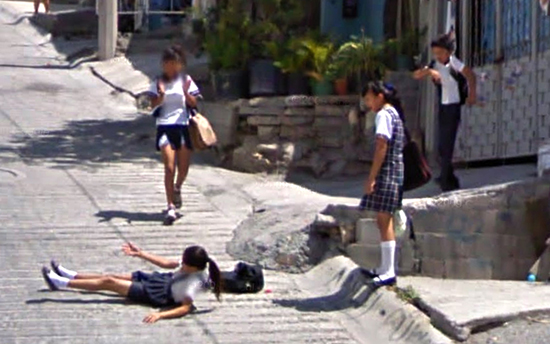
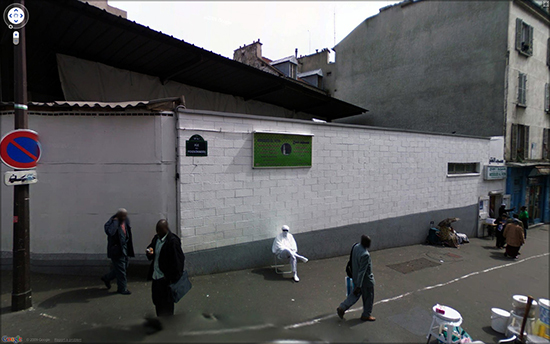
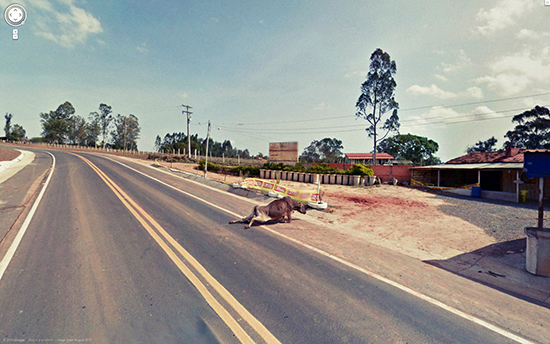
It may seem as though artists like Rafman are simply curating, rather than creating. However, the idea of taking a found image and adopting it as one’s own renders it fundamentally different from the original. GSV photography is an ostensibly new phenomenon, but it actually stems from a long legacy of found imagery and photography. Net Art, in particular, has a history of blurring the lines between fair use and copyright infringement.
Found photography is a kind of photography where the artist does not shoot the photograph itself. This genre has roots to the found object movement dating back to Marcel Duchamp in the early 1900s. Duchamp was known for taking something preexisting and elevating it into art, like a bicycle wheel atop a kitchen stool (Bicycle Wheel, 1951). Just as Duchamp appropriated mundane objects, GSV photographers appropriate everyday mapping tools to create a distinctive artistic project.
Michael Wolf also stirred up controversy over whether GSV should be considered photography when his 2010 project, Series of Unfortunate Events, from his Street View series, awarded him an honorable mention in the World Press Photo competition. In his series, Wolf selected and then photographed calamitous GSV images on his computer screen. His photos are dramatized, almost like movie stills, distorting our notion of actuality and fiction. Images included people falling on their bikes in the middle of a busy street and a man urinating behind an electric blue car. In another image, a white van is burning in the middle of a quintessential suburb. Although Wolf is presenting these disastrous scenarios, in Series of Unfortunate Events, he finds a way to elevate and evoke a sense of staging, maybe even humor. Additionally, his images have a stark, geometric quality to them that creates a kind of harmonious composition despite their dark content.
Wolf began his career as a photojournalist but later shifted into the realm of fine art photography. His recognition sparked a debate over the definition of photojournalism. Does the photographer have to be present in order to capture the image? Is it really street photography if the original image was taken by chance or algorithm? Many people found it preposterous to think that someone taking photos of a computer screen was considered photojournalism while others commended Wolf for his innovative approach.
“It’s a real file that I have, I’m not taking a screenshot,” Wolf told The British Journal of Photography. “I move the camera forward and backward in order to make an exact crop, and that’s what makes it my picture. It doesn’t belong to Google, because I’m interpreting Google; I’m appropriating Google.”3 The idea of the screenshot versus the re-produced image produced through capture on camera is what the debate really boils down to. At its essence, a screenshot is an exact replica with no imprint from the artist. The “file,” or reproduced image, on the other hand, is created by Wolf and demonstrates his reinterpretation. Whether this is through cropping, lighting, or displaying the photo in a more theatrical way, the artist adopts autonomy over the image and therefore possesses artistic ownership. Since Wolf has an intended style and deliberate method of curating and reappropriating these images, his series is a legitimate work of art.

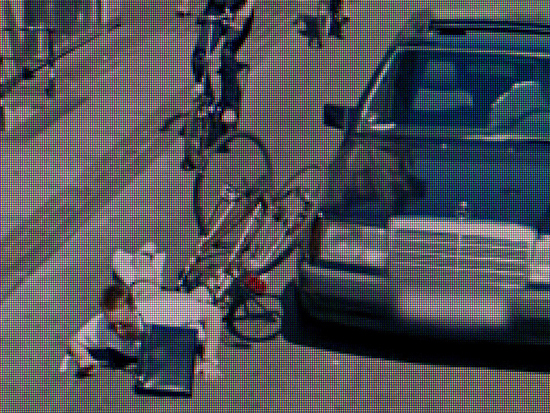
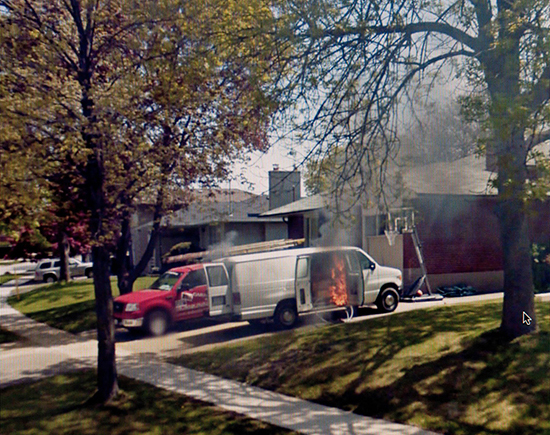
Since Google is accessible by anyone, this new genre has political and moral implications. Anyone can use the mapping image bank as they would a tube of paint or a mound of clay. Any artist, no matter their background, can impose their artistic vision upon this medium just as they would on a canvas. Whether you are a rich artist on the Upper West Side or a farmer in the boonies of Alabama, GSV is a readily available tool that doesn’t require higher education, wealth, or experience. These three photographers all came from different artistic backgrounds, yet found a way to innovatively use these tools for their work.
Doug Rickard’s photo series, A New American Picture, also takes a modern twist on classic vernacular photography. The name of his project alludes to great photo documentarians like Walker Evans, who brought images of urban decay and blighted communities to the fore. Rickard uses Street View to reimagine what street photography really means in the twenty-first century. Like Wolf, Rickard doesn’t simply take screenshots of the images he finds but instead rephotographs the images on his screen with a tripod-mounted camera.
According to his website, Rickard reinterprets the images taken from Google’s eleven-lens camera, called Dodeca 2360, and turns them into portraits of the “socially disenfranchised and economically powerless, those living an inversion of the American Dream.”4 By converting these images from digital computer screen to visual art, the artist turns images created by chance into deliberate portraits. This adds a new dimension, a new texture by reinterpreting the medium through his own eyes. His photos are highly stylized, with a distinct color palette featuring faded red and blue hues—perhaps hinting at the theme of contemporary America. The series has a distinct narrative, which legitimizes and authenticates the series. Rickard’s photos explore themes of consumerism, the nuclear family, and the wealth gap in America. One photo shows a desolate looking storefront with the words “Super Fair” painted on the building’s facade. The image is bleak, almost eerie, and perhaps presents a criticism on how capitalism entangled in American culture ultimately fails the poor. Rickard’s work poses and answers the question, What does disillusionment look like? How has the failed American Dream manifested in our contemporary culture?
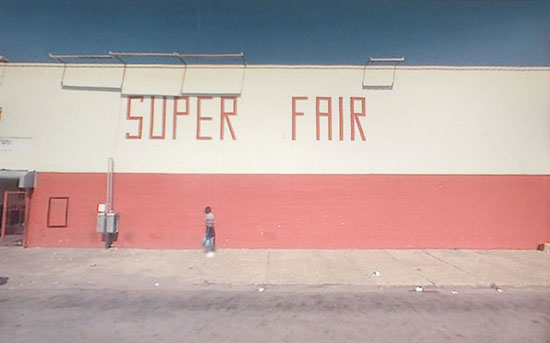
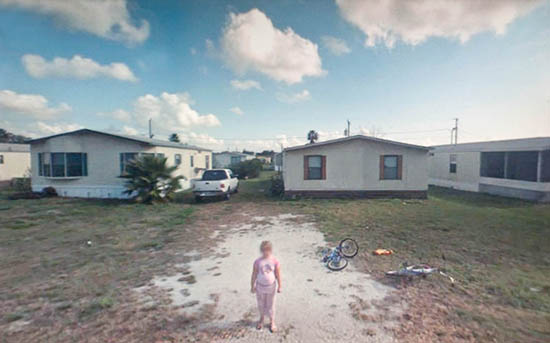

The artists’ intention and the debate over who can claim ownership, on the other hand, is more ambiguous. GSV images are taken by a car equipped with a multi-lensed camera. One could argue, then, that the Google employee driving the car qualifies as the original artist. These photographers adopt GSV imagery to present distinct themes and questions in their work. The artists’ selection, presentation, and dissemination of certain images elevates the photos from the aesthetically indifferent realm of GSV to the status of visual art. Without artists like Rafman, Rickard, and Wolf, these images may have never been viewed by anyone, whether in a gallery or on a blog. In this sense, these artists do have ownership over the images. The intention and creation of the images into a coherent collection distinguishes the project, and the GSV medium, as a discrete genre.
What is clear is that people can use this accessible tool to create an innovative art form that pushes the boundaries of the conventional medium. It makes us question the role of the spectator and whether the omniscient observance of Google is an invasion of privacy, or simply a sign of the modern times. GSV photography foregrounds images that we wouldn’t confront in our everyday lives–scenes of decay, social deviance, and even disaster.
- Brook, Peter. “Google’s Mapping Tools Spawn New Breed of Art Projects.” Wired, August 15, 2011. https://www.wired.com/2011/08/google-street-view/.
- “John Rafman,” Artsy, https://www.artsy.net/artist/jon-rafman
- NBC Photoblog. “Photographs from Google Street View: art, journalism or something else altogether?” February 28, 2011. http://photoblog.nbcnews.com/_news/2011/02/28/6152140-photographs-from-google-street-view-art-journalism-or-something-else-altogether.
- Lowensohn, Josh. “The Technology Behind Google’s Street View.” Cnet, May 31, 2007. https://www.cnet.com/news/the-tech-behind-googles-street-view/.